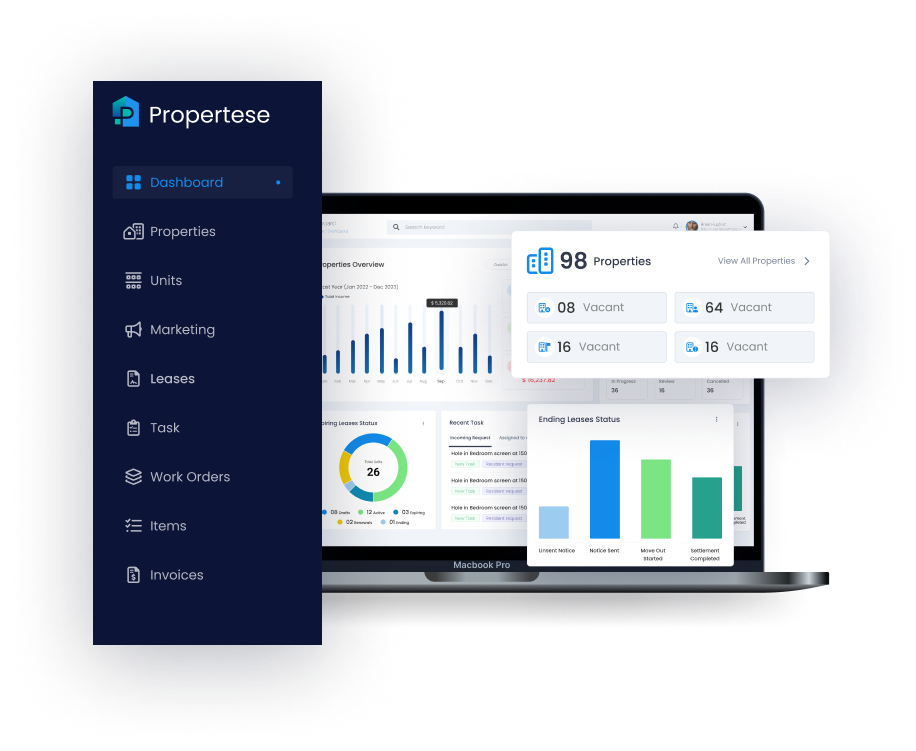
Ever approved a tenant who seemed perfect on paper, only to deal with months of late payments, property damage, or worse?
You’re not alone. Most property owners have been there, wondering how they missed the warning signs.
Here’s the hard truth: If you’re constantly dealing with problem tenants, your screening process is broken. It’s that simple.
The good news? You can fix it today. Not next month, not after another bad tenant – right now.
The Real Cost of Bad Tenant Screening
Let’s talk numbers for a second:
- Average eviction cost: $3,500-$10,000 (including legal fees, lost rent, and turnover costs)
- Average property damage from problem tenants: $1,800-$5,000
- Time wasted dealing with tenant issues: Countless hours of stress and frustration
When you add it all up, a single bad tenant can wipe out years of rental profits. And that’s before considering the headaches, late-night calls, and damaged relationships with neighbors.
Also read: How to Improve Tenant Retention in 2025: Best Tenant Retention Strategies
5 Signs Your Tenant Screening Process Is Failing You
Not sure if your current screening needs an overhaul? Here are the telltale signs:
1. You’re Making Gut Decisions
“They seemed really nice during the showing” isn’t a screening strategy. Neither is “They have a good job” or “They had cash for the deposit.”
If you’re making decisions based on first impressions rather than data, you’re gambling with your investment.
2. You’re Skipping Critical Checks
Many landlords run a credit check and think they’re done. But credit is just one piece of the puzzle. If you’re not checking rental history, employment verification, criminal background, and eviction records, you’re flying blind.
3. You’re Rushing to Fill Vacancies
Feeling pressured to get someone in quickly often leads to cutting corners. Yes, vacant units cost money, but bad tenants cost much more in the long run.
4. You’re Not Verifying Information
That perfect application? It might be full of lies. Studies show that up to 85% of applications contain some form of false or misleading information. Without proper verification, you’ll never know what’s real.
5. You’re Using an Inconsistent Process
If your screening changes from one applicant to the next, you’re not only risking fair housing violations, you’re also making it impossible to compare candidates objectively.
The 7-Step Tenant Screening Process That Actually Works
Ready to transform your tenant selection? Here’s a proven system that separates the great tenants from the problem ones:
Step 1: Create a Tenant Profile BEFORE You Advertise
Before you post that listing, get clear on exactly who your ideal tenant is. Write down:
- Minimum income requirements (typically 3x the monthly rent)
- Minimum credit score (usually 600+ for standard properties)
- Employment history requirements (stable job for at least 6 months)
- Rental history expectations (positive references from previous landlords)
- Deal-breakers (evictions, certain criminal histories, etc.)
This profile becomes your objective standard for all applicants, helping you stay consistent and fair.
Step 2: Pre-Screen Before Showing the Property
Don’t waste time showing your property to unqualified applicants. Use these pre-screening questions in your initial communication:
- “What is your monthly income?”
- “When would you be looking to move in?”
- “How long have you been at your current job?”
- “Do you have pets or smoke?”
- “Will anyone else be living with you?”
- “Have you ever been evicted or broken a lease?”
These simple questions will eliminate obviously unqualified candidates before you invest time in showings.
Propertese’s tenant screening tools can automate this pre-screening process, sending automated questionnaires to interested applicants and flagging potential issues before you’ve spent a minute of your time.
Step 3: Use a Comprehensive Application Form
Your application should collect all the information you need to make an informed decision:
- Full legal name and identification details
- Current and previous addresses (at least 5 years)
- Current and previous landlords’ contact information
- Employment information with supervisor contact details
- Income verification
- Personal and emergency contacts
- Authorization for background and credit checks
Propertese offers customizable application forms that capture all this critical information in one place, making it easy to reference and verify each detail.
Step 4: Verify EVERYTHING (And We Mean Everything)
This is where most screening processes break down. Verification is tedious but absolutely crucial.
Call every single reference and ask detailed questions:
- To previous landlords: “Did they pay rent on time? Any complaints? Would you rent to them again?”
- To employers: “Can you confirm their position and salary? How long have they worked there?”
Don’t just accept the phone numbers provided on the application. Look up the company or property management firm independently to ensure you’re not talking to the applicant’s friend.
Propertese’s verification tracking system helps you manage this process efficiently, documenting each verification step and flagging any discrepancies automatically.
Step 5: Run Complete Background Checks
A thorough background check should include:
- Credit report (including credit score and payment history)
- Criminal background check (national and local)
- Eviction history
- Sex offender registry check
- Bankruptcy and liens check
About 24% of screening reports contain criminal records, and 8% show prior evictions. These are critical red flags you can’t afford to miss.
Step 6: Apply Your Criteria Consistently
Now compare the verified information against your tenant profile from Step 1. The key here is consistency – apply the same standards to every applicant to avoid fair housing issues.
Document your decision-making process for each applicant. If you reject someone, note exactly which criteria they failed to meet. This documentation protects you in case your decision is questioned.
Step 7: Trust Your System, Not Your Gut
This is perhaps the hardest part. When your verification uncovers red flags, but you “like” the applicant, it’s tempting to make an exception.
Don’t do it.
Your screening system exists to protect you from exactly this situation. The most charming applicants are sometimes the biggest risks.
Common Tenant Screening Mistakes to Avoid
Even with a solid process, these common pitfalls can undermine your screening:
1. Screening Only the Primary Applicant
Every adult who will live in your property should be screened thoroughly. That quiet roommate or spouse might be the one with the problematic history.
2. Failing to Check References Thoroughly
Calling references and asking surface-level questions isn’t enough. Dig deeper with specific questions about payment history, property care, and whether there were any issues during the tenancy.
3. Not Documenting Your Process
If you can’t show exactly why you approved one applicant over another, you’re vulnerable to fair housing complaints. Keep detailed records of your screening process for each applicant.
4. Ignoring Red Flags Because of a Hot Market
In competitive rental markets, it’s tempting to overlook issues just to get the unit filled. Resist this urge – a vacancy is always cheaper than an eviction.
5. Using Outdated or Generic Screening Tools
Generic online background checks often miss crucial information. Invest in proper tenant screening services designed specifically for landlords.
How Propertese Transforms Your Tenant Screening
Implementing a comprehensive screening process manually can be overwhelming. That’s where Propertese comes in, offering:
- Automated application processing that collects and organizes all applicant information in one secure location
- Integrated background checks pulling from extensive databases for criminal, credit, and eviction histories
- Reference verification tracking to ensure no step is missed
- Consistent screening criteria applied to all applicants, reducing fair housing risks
- Digital document management keeping all screening records organized and accessible
With Propertese’s tenant screening system, you can complete a thorough screening in minutes instead of days, without sacrificing any of the critical verification steps.
Our customers report a 60% reduction in problem tenants after implementing our screening tools, and an average savings of $3,200 per property each year in reduced turnover and eviction costs.
The Bottom Line: Better Screening = Better Business
Your tenant screening process isn’t just a bureaucratic hurdle – it’s the most important risk management tool in your property management arsenal.
When done right, tenant screening:
- Protects your investment from damage and neglect
- Ensures consistent rental income
- Reduces turnover and vacancy costs
- Prevents costly and stressful evictions
- Creates a more positive rental environment for everyone
The difference between property owners who consistently make money and those who struggle isn’t luck – it’s systematic tenant screening.
Don’t wait for another problem tenant to prove the point. Implement these changes today, and stop the cycle of tenant troubles before they begin.
Ready to transform your tenant screening process?
Propertese offers a comprehensive screening solution designed specifically for property owners who want better tenants without the hassle of manual verification. Book a demo today to see how our automated screening tools can protect your investment and boost your rental returns.
Table of Contents
Stay Updated
Subscribe to get the latest news, industry trends, blog posts, and updates...




